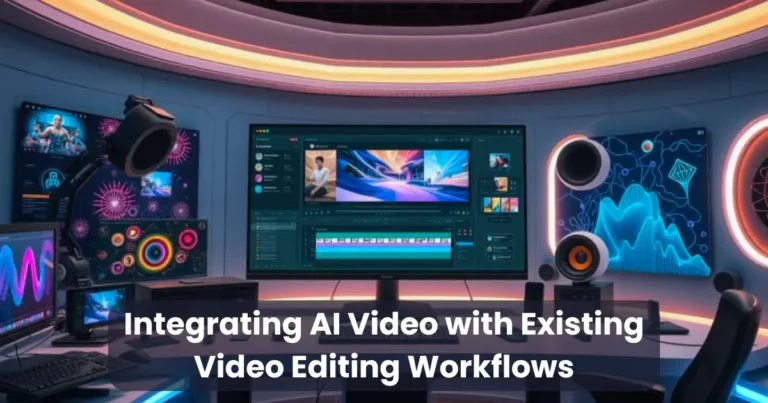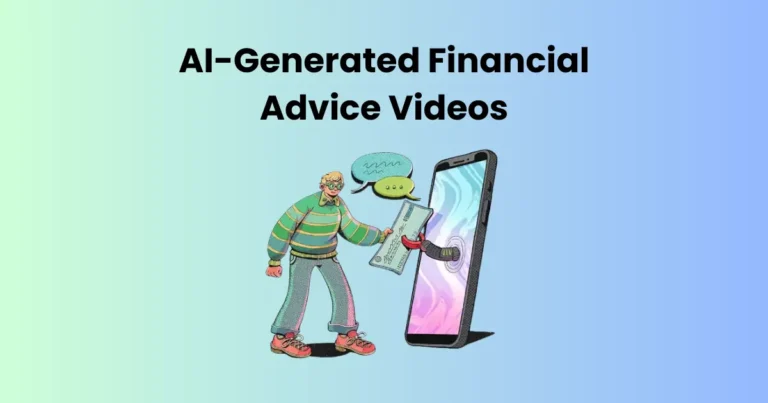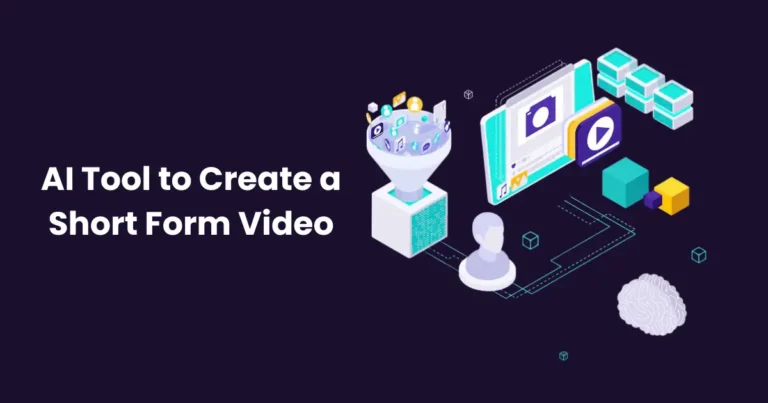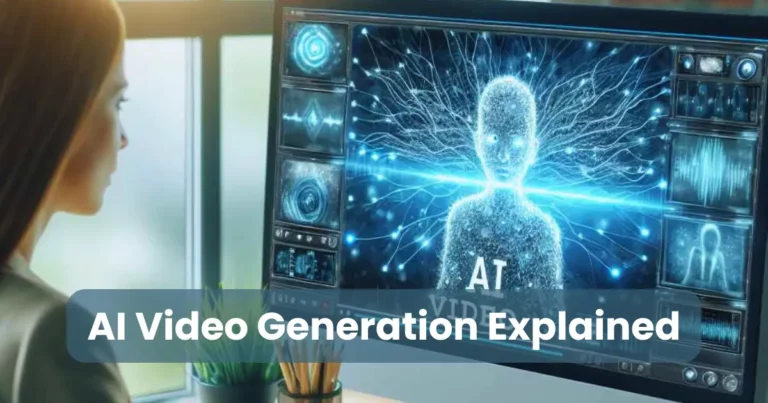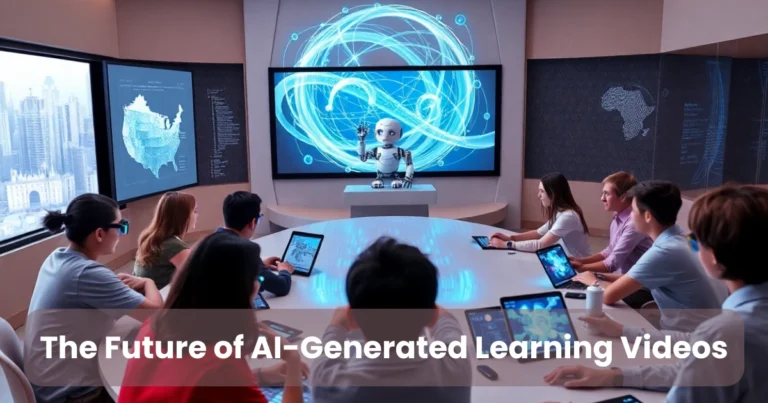Learning Resources for Advanced AI Video Generation
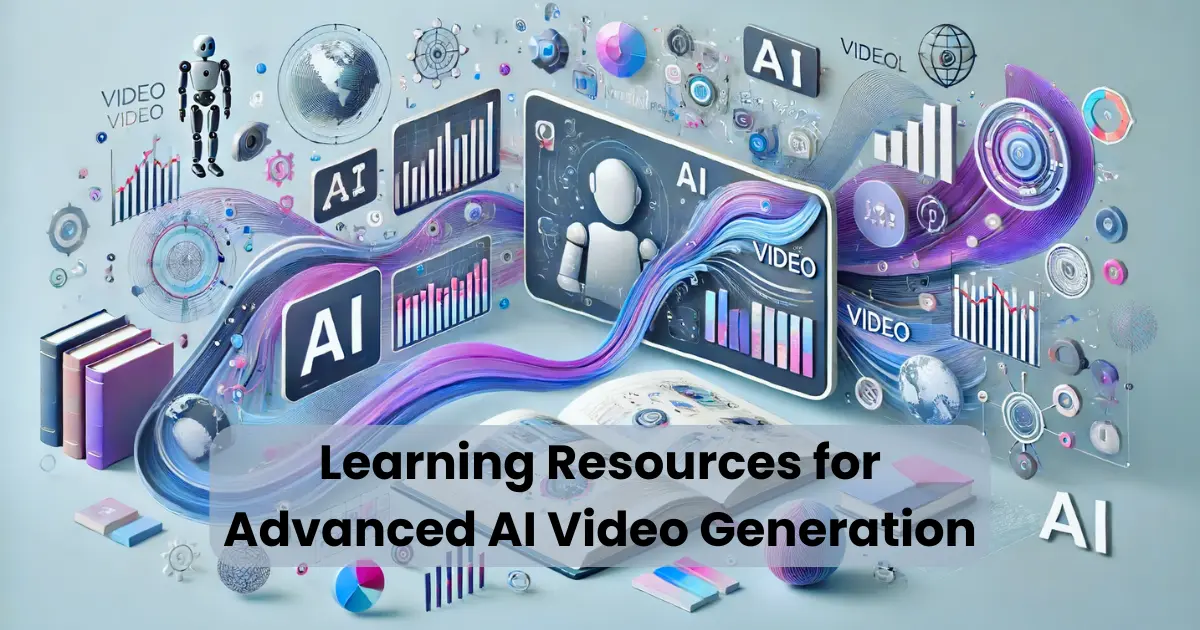
Contents
- 1 Why Learn Advanced AI Video Generation?
- 2 Types of Learning Resources
- 3 Best Platforms Offering Learning Resources for Advanced AI Video Generation
- 4 Top YouTube Channels to Follow
- 5 Must-Read Books on AI Video Generation
- 5.1 1 Deep Learning by Ian Goodfellow, Yoshua Bengio, and Aaron Courville
- 5.2 2 Generative Deep Learning by David Foster
- 5.3 3 Hands-On Computer Vision with TensorFlow 2 by Benjamin Planche and Eliot Andres
- 5.4 4 Programming Machine Learning by Paolo Perrotta
- 5.5 5 Practical Deep Learning for Cloud, Mobile & Edge by Anirudh Koul, Siddha Ganju, and Meher Kasam
- 5.6 6 GANs in Action by Jakub Langr and Vladimir Bok
- 6 AI Communities That Enhance Learning
- 7 Recommended Tools and Tutorials
- 8 Tips for Effectively Using These Resources
In an era where technology evolves faster than ever, learning resources for advanced AI video generation have become essential for professionals aiming to stay competitive. From hyper-realistic deepfakes to fully AI-generated films and advertisements, the applications of AI in video creation are rapidly expanding. To master these innovations, one must go beyond basic tutorials and invest time in comprehensive, high-quality educational content. This article explores the best tools, platforms, and strategies to help you effectively learn and excel in the domain of advanced AI video generation. Whether you’re a developer, creative artist, or tech enthusiast, these resources will guide you to the forefront of AI-driven storytelling.
Why Learn Advanced AI Video Generation?
Advanced AI video generation is no longer just a futuristic concept—it’s a rapidly growing field that is revolutionizing how we create, edit, and interact with video content. From marketing campaigns and film production to education and virtual reality, AI is transforming the creative landscape across industries.
Learning how to generate videos using AI gives you a competitive edge by allowing you to automate production, personalize content at scale, and reduce costs. It empowers creators to generate high-quality visuals without expensive equipment or large teams. Moreover, understanding the underlying technology—from deep learning models to neural rendering—enables you to innovate, customize solutions, and even build your own AI-powered tools.
In a world where video is the most consumed media format, professionals equipped with learning resources for advanced AI video generation will lead the way in creative innovation, efficiency, and audience engagement. By mastering this skill set, you can future-proof your career and open doors to exciting opportunities in AI research, content creation, and software development.
Types of Learning Resources
To fully understand and apply learning resources for advanced AI video generation, it’s essential to explore the different types available. Each category serves a unique purpose—some build foundational knowledge, while others offer hands-on practice or insight into cutting-edge research.

1 Online Courses
Online courses are structured, progressive, and often come with certification. They’re among the most comprehensive learning resources for advanced AI video generation because they offer curated content, real-world projects, and expert guidance. Platforms like Coursera, Udacity, and edX provide courses taught by industry leaders and university professors. You can study topics such as deep learning, computer vision, and generative models in a guided, sequential manner.
2 YouTube Channels
For visual learners, YouTube channels provide an accessible way to grasp complex AI topics. Many AI practitioners and educators break down technical concepts through tutorials, demos, and code walkthroughs. Channels such as The AI Epiphany, Two Minute Papers, and CodeEmporium consistently deliver high-quality learning resources for advanced AI video generation, making the learning process more engaging and interactive.
3 Academic Journals and Research Papers
If you want to stay on the cutting edge, academic literature is essential. Platforms like arXiv, Google Scholar, and Semantic Scholar host thousands of peer-reviewed papers that cover innovations in generative adversarial networks (GANs), diffusion models, and video synthesis. These papers often introduce techniques months or even years before they appear in mainstream tools—making them critical learning resources for advanced AI video generation.
4 eBooks and Whitepapers
eBooks and whitepapers provide in-depth explanations of AI principles and technologies. Many tech companies, such as NVIDIA, Adobe, and OpenAI, release whitepapers that explain their latest AI breakthroughs.
5 AI Communities and Forums
Communities play a crucial role in the learning journey. Forums like Reddit’s r/MachineLearning, Stack Overflow, and Hugging Face’s discussion boards offer spaces to ask questions, share projects, and receive feedback. They are dynamic, evolving learning resources for advanced AI video generation, driven by real-world experience and collaborative problem-solving.
6 Tool-Specific Tutorials
As AI tools evolve, so do the resources that support them. Tutorials designed for specific platforms—like Runway ML, Pika Labs, or Sora by OpenAI—help you learn how to use these technologies efficiently. These resources often come in the form of blogs, video walkthroughs, or official documentation, offering step-by-step guidance for implementation.
By leveraging a variety of learning resources for advanced AI video generation, you can gain both theoretical knowledge and practical experience. Mixing structured courses with real-world forums, open-access research, and hands-on tools will ensure you become a well-rounded AI video expert.
Best Platforms Offering Learning Resources for Advanced AI Video Generation
Choosing the right platform can make or break your learning experience. Fortunately, several leading platforms specialize in providing high-quality learning resources for advanced AI video generation. These platforms combine expert instruction, practical exercises, and the latest research to help you stay ahead in this evolving field.
1 Coursera
Coursera partners with top universities and companies to offer in-depth courses in AI, deep learning, and computer vision. You can find specialization tracks like “Deep Learning” by Andrew Ng and advanced topics related to video synthesis and GANs.
2 Udacity
Udacity stands out for its Nanodegree programs, which provide hands-on projects and mentorship. Its AI and computer vision tracks often include video-related modules, teaching you how to build applications with neural networks, OpenCV, and more. For serious learners, Udacity offers an immersive experience backed by industry experts.
3 Runway ML
Runway ML is both a tool and a learning hub for creators looking to harness AI in their video projects. It offers real-time generative video tools powered by models like Stable Diffusion and Gen-2. In addition to the tool itself, Runway provides tutorials and community support, making it a great source of learning resources for advanced AI video generation.
4 DeepLearning.AI
Founded by Andrew Ng, DeepLearning.AI offers specialized content that focuses on the practical and theoretical aspects of machine learning and generative models. Courses like “Generative Adversarial Networks” and “Building Systems with ChatGPT API” help you understand the core tech behind AI-generated video systems.
5 MIT OpenCourseWare
For those who prefer academic-level depth, MIT OpenCourseWare provides free access to lectures and materials from real MIT classes. Topics like computer vision, machine learning, and AI video modeling are available, giving you a firm theoretical foundation at no cost.
6 YouTube & GitHub
Platforms like YouTube and GitHub offer practical, up-to-date learning resources for advanced AI video generation. Many open-source contributors share tutorials, model implementations, and walkthroughs that show you how to build AI video tools from scratch. Channels and repositories are perfect for self-paced learners looking for real-world applications.
7 Hugging Face
Hugging Face is more than just a model repository—it’s a vibrant AI community. It offers pretrained models, notebooks, and documentation to help you explore generative video AI. The Hugging Face course and associated forums make it one of the most interactive learning resources for advanced AI video generation.
By exploring these platforms, you can access cutting-edge learning resources for advanced AI video generation that blend theory with real-world application. Whether you’re a beginner aiming to understand the basics or a professional seeking advanced skill development, these platforms offer everything you need to succeed.
Top YouTube Channels to Follow
YouTube is one of the most accessible and dynamic sources of learning resources for advanced AI video generation. Many AI experts, developers, and educators use their channels to break down complex concepts, share project demos, and review the latest tools in AI-powered video. These channels can fast-track your learning by offering free, practical, and regularly updated content.

1 The AI Epiphany
This channel focuses on demystifying artificial intelligence and machine learning. It covers topics like deepfake technology, generative adversarial networks (GANs), and video AI tools like Sora and Runway ML. With detailed breakdowns and real-world examples, it’s one of the most practical learning resources for advanced AI video generation.
2 CodeEmporium
CodeEmporium offers hands-on tutorials that guide you through the actual coding behind AI models. From building GANs to integrating AI APIs for video generation, this channel is ideal for those who prefer a technical deep dive into the mechanics of AI systems.
3 Two Minute Papers
Short on time? Two Minute Papers delivers concise, animated explanations of cutting-edge AI research papers. It often covers advancements in generative video, making it a valuable supplement to your core learning resources for advanced AI video generation.
4 AssemblyAI
Known for its speech-to-text innovations, AssemblyAI also provides content on multimodal AI and real-time video processing. Their tutorials often combine audio and video AI, making them excellent for learners exploring end-to-end generative pipelines.
5 ArXiv Insights
If you’re looking to bridge academic research with practical understanding, ArXiv Insights breaks down peer-reviewed AI papers into digestible video summaries. You’ll find content on diffusion models, transformer networks, and more—all relevant to AI video generation.
6 Yannic Kilcher
Yannic is known for his in-depth walkthroughs of the latest AI breakthroughs. His videos often include model evaluations, architecture comparisons, and real-world use cases. These insights make his channel a critical resource for anyone mastering learning resources for advanced AI video generation.
7 The Coding Train
While not AI-exclusive, The Coding Train dives into creative coding with a focus on machine learning and generative art. Many of its projects touch on video generation using p5.js, TensorFlow.js, and other tools, making it a fun and educational stop for aspiring video AI creators.
These YouTube channels provide diverse and powerful learning resources for advanced AI video generation. Whether you need conceptual clarity, coding practice, or the latest research updates, these creators consistently deliver high-value content to keep your skills sharp and up to date.
Must-Read Books on AI Video Generation
Books offer a deep, structured understanding that complements hands-on tools and video tutorials. If you’re serious about mastering AI video, you need foundational and advanced texts. The following must-read books serve as excellent learning resources for advanced AI video generation, covering essential theories, neural networks, computer vision, and generative models.

1 Deep Learning by Ian Goodfellow, Yoshua Bengio, and Aaron Courville
Often considered the bible of AI, this book explores the core principles of deep learning—essential for anyone working in video generation. It delves into neural networks, backpropagation, and optimization strategies that directly power generative video tools today.
2 Generative Deep Learning by David Foster
This book takes you on a practical journey through building generative models like GANs and VAEs. It includes real-world code examples and exercises, making it one of the most effective learning resources for advanced AI video generation. You’ll learn to generate not just images but animations and sequences with deep neural nets.
3 Hands-On Computer Vision with TensorFlow 2 by Benjamin Planche and Eliot Andres
Since computer vision is a core component of AI video generation, this book helps bridge theory and application. From object detection to video frame analysis, it provides hands-on guidance using TensorFlow and OpenCV, ideal for building your own AI-powered video tools.
4 Programming Machine Learning by Paolo Perrotta
This book simplifies many AI concepts for programmers and developers. It’s packed with visual examples and code-first chapters, making it a beginner-friendly yet powerful resource to understand the mechanics behind video AI models.
5 Practical Deep Learning for Cloud, Mobile & Edge by Anirudh Koul, Siddha Ganju, and Meher Kasam
AI video generation often extends beyond the desktop—into cloud rendering, mobile apps, and edge devices. This book teaches you how to deploy deep learning models in real-world environments. It’s a vital addition to your learning resources for advanced AI video generation toolkit.
6 GANs in Action by Jakub Langr and Vladimir Bok
If you’re especially interested in generative adversarial networks, this book provides both theory and implementation. With case studies and projects like AI-generated art and video, it helps you understand how GANs can be used creatively for video synthesis and manipulation.
These books serve as high-quality, in-depth learning resources for advanced AI video generation. Whether you’re a beginner exploring the fundamentals or an expert diving into niche techniques, these texts provide the theoretical and p
AI Communities That Enhance Learning
In the rapidly evolving world of artificial intelligence, collaboration is key. By joining active communities, you can stay updated with the latest innovations, receive peer feedback, and gain access to cutting-edge tools and tutorials. These communities act as living, breathing learning resources for advanced AI video generation, offering collective insight that no single course or book can provide.

1 Hugging Face Community
Hugging Face isn’t just a model hub—it’s a thriving community of researchers, developers, and AI enthusiasts. Through discussion forums, Discord channels, and shared notebooks, users collaborate on generative AI projects, including video generation. It’s one of the most vibrant learning resources for advanced AI video generation on the web.
2 Reddit (r/MachineLearning & r/Artificial)
Reddit’s AI-focused subreddits are home to some of the most in-depth and up-to-date discussions on machine learning, generative models, and AI ethics. You’ll find regular posts on new tools, academic papers, and use cases related to AI-generated video. It’s a great place to ask questions and crowdsource solutions.
3 Discord Servers (AI Coffeehouse, ML Collective)
Numerous Discord servers now serve as real-time AI learning hubs. Communities like AI Coffeehouse and ML Collective offer channels dedicated to generative video, deep learning frameworks, and even career advice.
4 LinkedIn Groups & AI Think Tanks
LinkedIn groups like “AI Innovators” or “Artificial Intelligence & Deep Learning” bring together professionals from academia, industry, and startups. Members share webinars, research findings, and tool updates that contribute directly to your learning curve in AI video generation.
5 Stack Overflow & Cross Validated
These Q&A forums remain unmatched for problem-solving. Whether you’re debugging a training model or optimizing your video synthesis pipeline, chances are someone has asked (and answered) your exact question. As technical learning resources for advanced AI video generation, these platforms provide instant support from a global network of developers.
6 GitHub Discussions
Many AI projects on GitHub include active “Discussions” and “Issues” sections. Participating in open-source repositories not only exposes you to code but also helps you learn through community contributions and troubleshooting threads. It’s a practical way to engage with others who are building advanced AI video tools.
Joining one or more of these communities amplifies your learning experience. They offer interactive, crowd-sourced learning resources for advanced AI video generation that evolve in real time—giving you access to diverse perspectives, support, and opportunities to collaborate on groundbreaking projects.
Recommended Tools and Tutorials
Once you grasp the theory and community discussions, it’s time to dive into hands-on practice. The best way to reinforce your knowledge is by using industry tools and guided tutorials. These platforms not only provide intuitive interfaces and real-world datasets, but they also serve as some of the most practical learning resources for advanced AI video generation.

1 Runway ML
Runway ML is one of the most accessible AI video generation platforms. It allows users to generate videos using text prompts, style transfer, and motion tracking. Runway offers built-in tutorials for creators and developers of all levels. As a bonus, it also integrates with tools like Adobe After Effects, making it an ideal learning bridge between creativity and AI.
2 Sora by OpenAI (When Available)
Although still in limited release, OpenAI’s Sora is pushing the limits of video generation using diffusion models. Keep an eye on OpenAI’s updates, as their tools typically come with documentation, notebooks, and explainer videos—perfect learning resources for advanced AI video generation when they’re publicly available.
3 Pika Labs
Pika Labs specializes in text-to-video and AI-enhanced video editing. Their drag-and-drop UI and frequent tutorial drops make it easy for users to learn complex processes in manageable steps. The platform is rapidly becoming a favorite for creators seeking practical learning resources for advanced AI video generation without requiring heavy coding.
4 Kaiber AI
Kaiber AI is designed for music videos and visual storytelling using AI-generated scenes. With a library of tutorials and a creator-friendly dashboard, Kaiber makes AI video accessible for artists, animators, and marketers alike. It’s a powerful tool for experimenting with visual aesthetics and narrative pacing.
5 Google Colab Notebooks
For users who want full control over their AI workflows, Google Colab offers free GPU-powered coding environments. Popular tutorials include building GANs, training StyleGAN2 models, and applying video-to-video synthesis techniques. These notebooks are often shared by experts and serve as customizable learning resources for advanced AI video generation.
6 YouTube Playlists and GitHub Repos
Multiple GitHub repositories and curated YouTube playlists cover tutorials on AI video generation pipelines—from dataset preparation to model evaluation. Look for tutorials by freeCodeCamp, Sentdex, and AI Explained, which combine clarity with depth.
These tools and tutorials are more than just apps or videos—they are dynamic and evolving learning resources for advanced AI video generation. Whether you prefer GUI-based platforms or code-heavy environments, these resources will help you build, iterate, and refine your skills with real-world applications.
Tips for Effectively Using These Resources
Now that you’ve explored the best platforms, tools, books, and communities, the next step is using them efficiently. Many learners dive into resources without structure, leading to frustration or burnout. To make the most of your journey, here are proven strategies for maximizing the value of your learning resources for advanced AI video generation.

1 Set Clear Learning Goals
Before diving into any course or tutorial, define what you want to achieve. Are you aiming to master text-to-video tools, build your own GAN, or explore animation pipelines? Setting SMART (Specific, Measurable, Achievable, Relevant, and Time-bound) goals helps you stay focused and track progress across your learning resources.
2 Combine Theory with Practice
It’s tempting to read book after book or watch endless tutorials—but without practical application, the knowledge fades. For every hour of theory, spend another hour implementing it using actual AI video generation tools. This hands-on approach transforms passive learning into deep understanding.
3 Use Community Feedback
Don’t learn in isolation. Share your projects on platforms like GitHub, Reddit, or Discord, and request feedback. Community critiques not only highlight blind spots but also introduce you to better workflows and updated techniques—making your chosen platforms even more powerful learning resources for advanced AI video generation.
4 Keep a Project-Based Portfolio
Apply each new skill by building small projects. Start with simple clips, experiment with tools like Runway or Kaiber, and scale up to complex generative sequences. A portfolio not only reinforces what you learn but also positions you for freelancing or job opportunities in the field.
5 Stay Consistent and Updated
AI evolves at a rapid pace. Make learning a weekly habit and revisit your favorite blogs, GitHub repos, and YouTube channels for updates. Subscribing to newsletters or following researchers ensures your learning resources for advanced AI video generation remain relevant and effective.
6 Evaluate and Pivot When Needed
Not every course or tool will suit your style or goals. Periodically assess your progress and don’t hesitate to switch resources if something isn’t delivering value. Being flexible in your learning approach ensures long-term success.
Conclusion
Mastering AI video generation requires more than just curiosity—it demands access to the right learning resources for advanced AI video generation and a focused, consistent approach. Throughout this article, we’ve explored top platforms, books, communities, and tools that empower you to dive deep into this exciting field. By actively engaging with these resources and applying the practical tips shared, you can accelerate your skills and create cutting-edge AI-generated videos.
Remember, the world of AI video generation is constantly evolving. Staying connected with communities, experimenting with new tools, and continuously learning from diverse resources will keep you ahead of the curve. Whether you are a developer, artist, or researcher, leveraging these learning resources for advanced AI video generation will open doors to innovation and creative expression.

